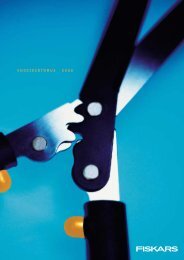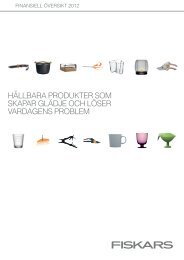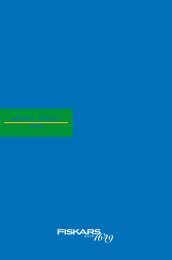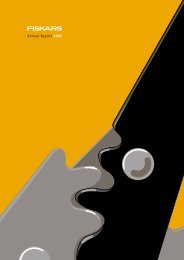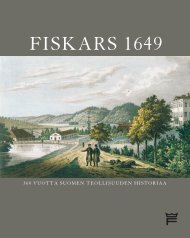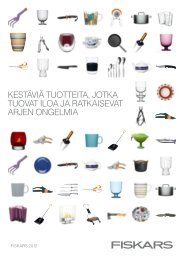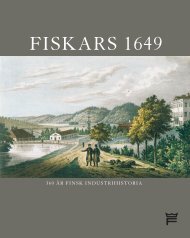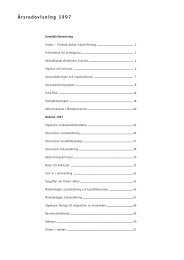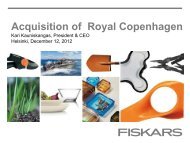FISKARS 1649 â 360 years of Finnish industrial history
FISKARS 1649 â 360 years of Finnish industrial history
FISKARS 1649 â 360 years of Finnish industrial history
Create successful ePaper yourself
Turn your PDF publications into a flip-book with our unique Google optimized e-Paper software.
Fiskars <strong>1649</strong><br />
Fiskars <strong>1649</strong><br />
The old iron scales in<br />
Stockholm Iron Market.<br />
All the iron was checked and<br />
weighed on the Crown scales<br />
before being loaded onto ships<br />
and sold.<br />
The tenant farmers’ daily labour for<br />
the ironworks was carefully noted<br />
down on pieces <strong>of</strong> wood<br />
Water power from the rapids was used to work the<br />
crusher hammers, bar-iron hammers and bellows.<br />
Iron-making in blast furnaces and hammer mills<br />
remained technically much the same up to the 19th<br />
century.<br />
Shipping iron to Stockholm and Tallinn<br />
Fiskars made nails, wire, knives, hoes and reinforced<br />
wheels from pig iron. The ironworks also made<br />
cast-iron products such as pots and frying pans.<br />
The finished goods were transported by sea via<br />
the port <strong>of</strong> Pohjankuru either to Stockholm or to<br />
the provinces along the south <strong>of</strong> the Gulf <strong>of</strong> Finland.<br />
Some <strong>of</strong> the vessels were owned by the ironworks,<br />
some were chartered. In the 17th century, merchant<br />
shipping in the Baltic was otherwise dominated by<br />
the Dutch.<br />
Most <strong>of</strong> Fiskars’ bar iron was exported as it was<br />
to Sweden, where it was sold at the Iron Market<br />
in Stockholm’s Old Town. The ships also carried<br />
firewood and agricultural produce. Grain and salt<br />
were the main products brought back from Tallinn,<br />
though the cargo also included scarce luxuries such<br />
as wine, tobacco, apples, herring and onions. In 1672,<br />
Thorwöste received a shipment comprising a barrel<br />
<strong>of</strong> carrots, a barrel <strong>of</strong> parsnips, half a barrel <strong>of</strong> salmon<br />
and some cucumbers for his personal consumption.<br />
Fiskars attracted workers from near and afar<br />
Iron-making required skilled labour. In the 1640s,<br />
Thorwöste was granted permission to hire specially<br />
trained people from abroad, i.e. Sweden, Germany<br />
and the Netherlands. Some German blacksmiths<br />
and a few Walloons moved to Fiskars at this time.<br />
More workers were recruited from the parish <strong>of</strong><br />
Pohja. In the late 17th and early 18th centuries, the<br />
smiths and pot casters had such names as Tysk,<br />
Lijhr, Fransos and Jöran Monsieur. In 1656, the<br />
Fiskars and Antskog ironworks had a total <strong>of</strong> 54<br />
workers, including a master builder, a furnace<br />
supervisor and sixteen smiths.<br />
Only part <strong>of</strong> the worker’s wages was paid in<br />
cash, the bulk being paid in goods which the owner<br />
would advance if required. The peasants working<br />
at the ironworks were exempt from military service;<br />
instead, they did ‘daytale’, compulsory work without<br />
pay. In 1657, the peasants worked 1,5 days a week<br />
at the ironworks.<br />
18<br />
19



